weight NISSAN CUBE 2010 3.G Towing Guide
[x] Cancel search | Manufacturer: NISSAN, Model Year: 2010, Model line: CUBE, Model: NISSAN CUBE 2010 3.GPages: 30, PDF Size: 1.01 MB
Page 16 of 30
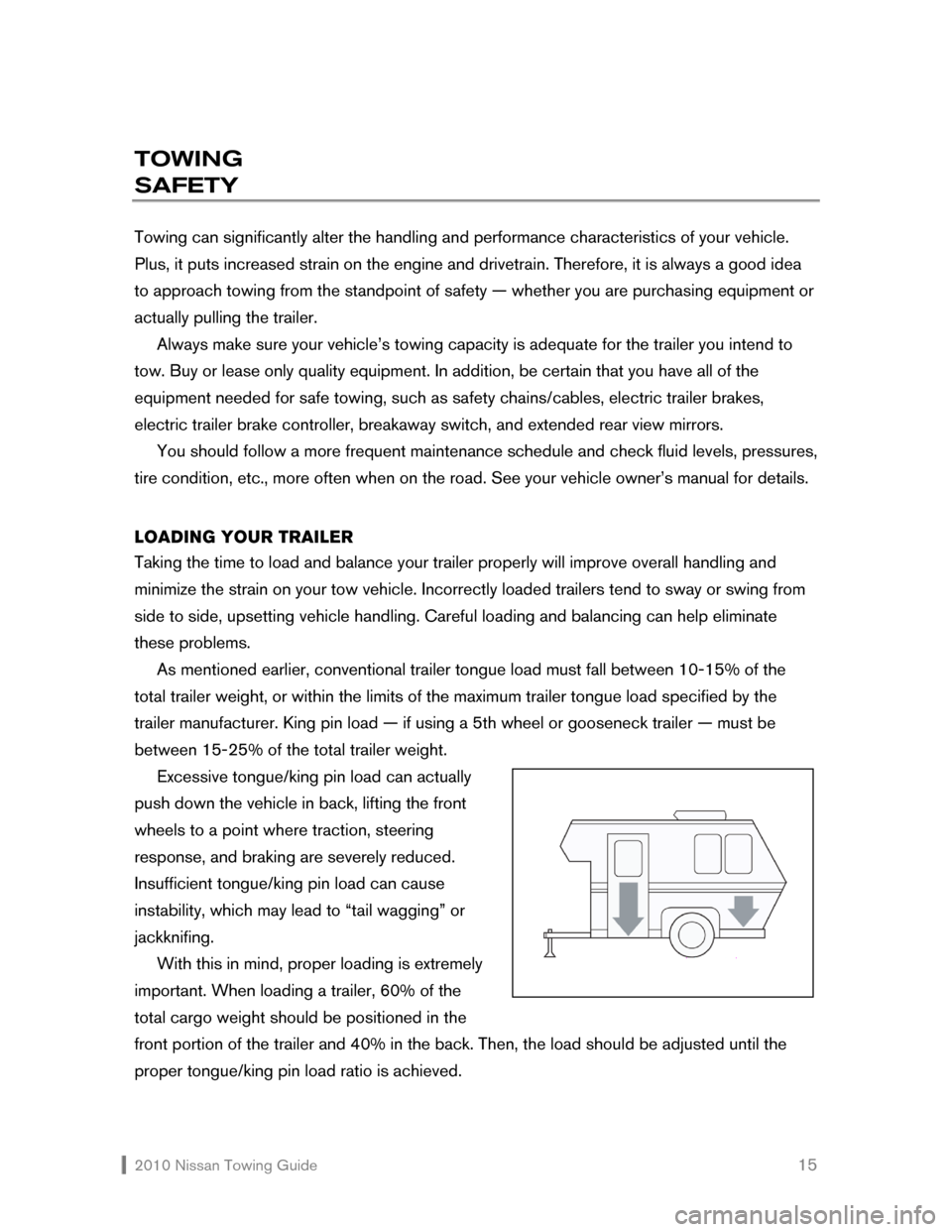
2010 Nissan Towing Guide 15
TOWING
SAFETY
Towing can significantly alter the handling and performance characteristics of your vehicle.
Plus, it puts increased strain on the engine and drivetrain. Therefore, it is always a good idea
to approach towing from the standpoint of safety — whether you are purchasing equipment or
actually pulling the trailer.
Always make sure your vehicle’s towing capacity is adequate for the trailer you intend to
tow. Buy or lease only quality equipment. In addition, be certain that you have all of the
equipment needed for safe towing, such as safety chains/cables, electric trailer brakes,
electric trailer brake controller, breakaway switch, and extended rear view mirrors.
You should follow a more frequent maintenance schedule and check fluid levels, pressures,
tire condition, etc., more often when on the road. See your vehicle owner’s manual for details.
LOADING YOUR TRAILER
Taking the time to load and balance your trailer properly will improve overall handling and
minimize the strain on your tow vehicle. Incorrectly loaded trailers tend to sway or swing from
side to side, upsetting vehicle handling. Careful loading and balancing can help eliminate
these problems.
As mentioned earlier, conventional trailer tongue load must fall between 10-15% of the
total trailer weight, or within the limits of the maximum trailer tongue load specified by the
trailer manufacturer. King pin load — if using a 5th wheel or gooseneck trailer — must be
between 15-25% of the total trailer weight.
Excessive tongue/king pin load can actually
push down the vehicle in back, lifting the front
wheels to a point where traction, steering
response, and braking are severely reduced.
Insufficient tongue/king pin load can cause
instability, which may lead to “tail wagging” or
jackknifing.
With this in mind, proper loading is extremely
important. When loading a trailer, 60% of the
total cargo weight should be positioned in the
front portion of the trailer and 40% in the back. Then, the load should be adjusted until the
proper tongue/king pin load ratio is achieved.
Page 17 of 30
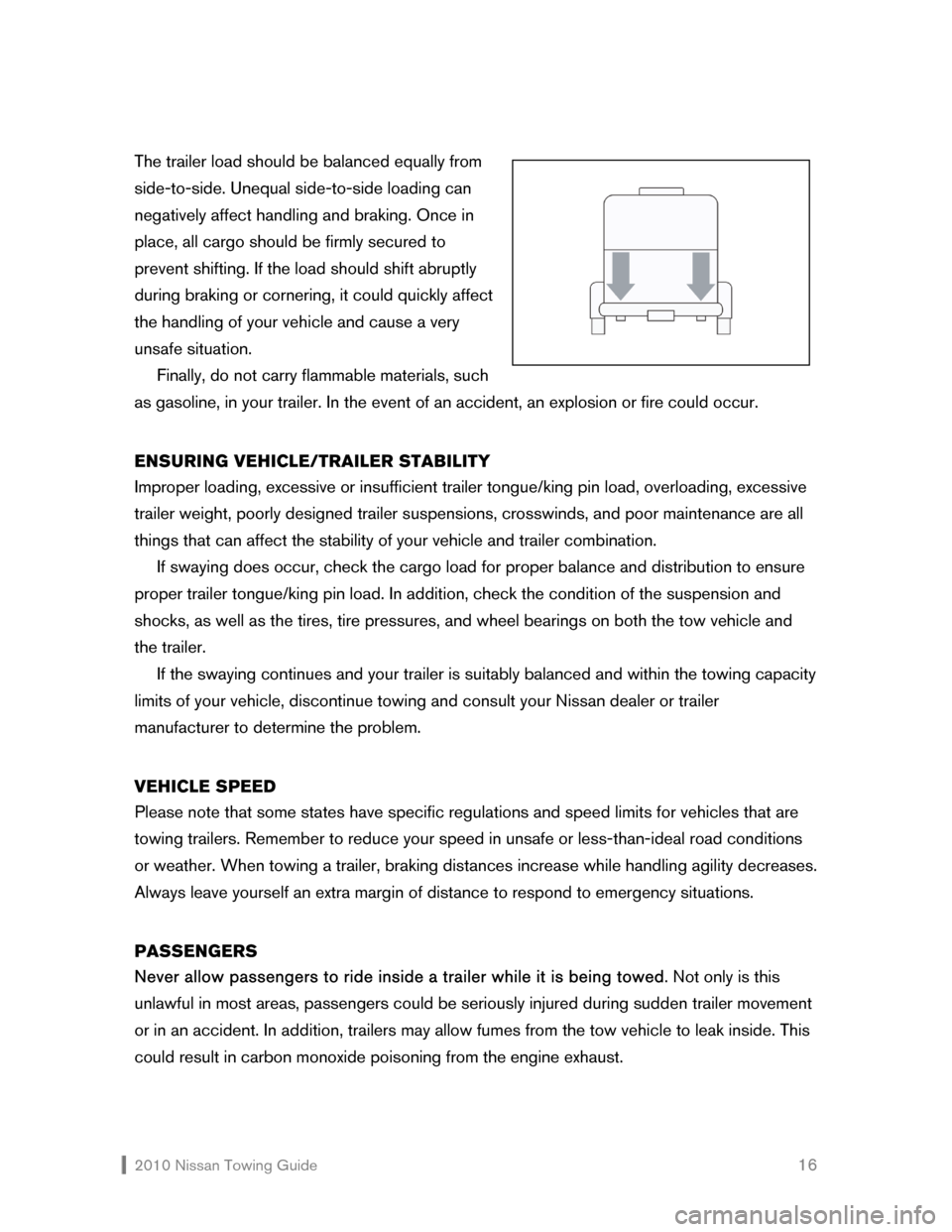
2010 Nissan Towing Guide 16 The trailer load should be balanced equally from
side-to-side. Unequal side-to-side loading can
negatively affect handling and braking. Once in
place, all cargo should be firmly secured to
prevent shifting. If the load should shift abruptly
during braking or cornering, it could quickly affect
the handling of your vehicle and cause a very
unsafe situation.
Finally, do not carry flammable materials, such
as gasoline, in your trailer. In the event of an accident, an explosion or fire could occur.
ENSURING VEHICLE/TRAILER STABILITY
Improper loading, excessive or insufficient trailer tongue/king pin load, overloading, excessive
trailer weight, poorly designed trailer suspensions, crosswinds, and poor maintenance are all
things that can affect the stability of your vehicle and trailer combination.
If swaying does occur, check the cargo load for proper balance and distribution to ensure
proper trailer tongue/king pin load. In addition, check the condition of the suspension and
shocks, as well as the tires, tire pressures, and wheel bearings on both the tow vehicle and
the trailer.
If the swaying continues and your trailer is suitably balanced and within the towing capacity
limits of your vehicle, discontinue towing and consult your Nissan dealer or trailer
manufacturer to determine the problem.
VEHICLE SPEED
Please note that some states have specific regulations and speed limits for vehicles that are
towing trailers. Remember to reduce your speed in unsafe or less-than-ideal road conditions
or weather. When towing a trailer, braking distances increase while handling agility decreases.
Always leave yourself an extra margin of distance to respond to emergency situations.
PASSENGERS
Never allow passengers to ride inside a trailer while it is being towed. Not only is this
unlawful in most areas, passengers could be seriously injured during sudden trailer movement
or in an accident. In addition, trailers may allow fumes from the tow vehicle to leak inside. This
could result in carbon monoxide poisoning from the engine exhaust.
Page 19 of 30
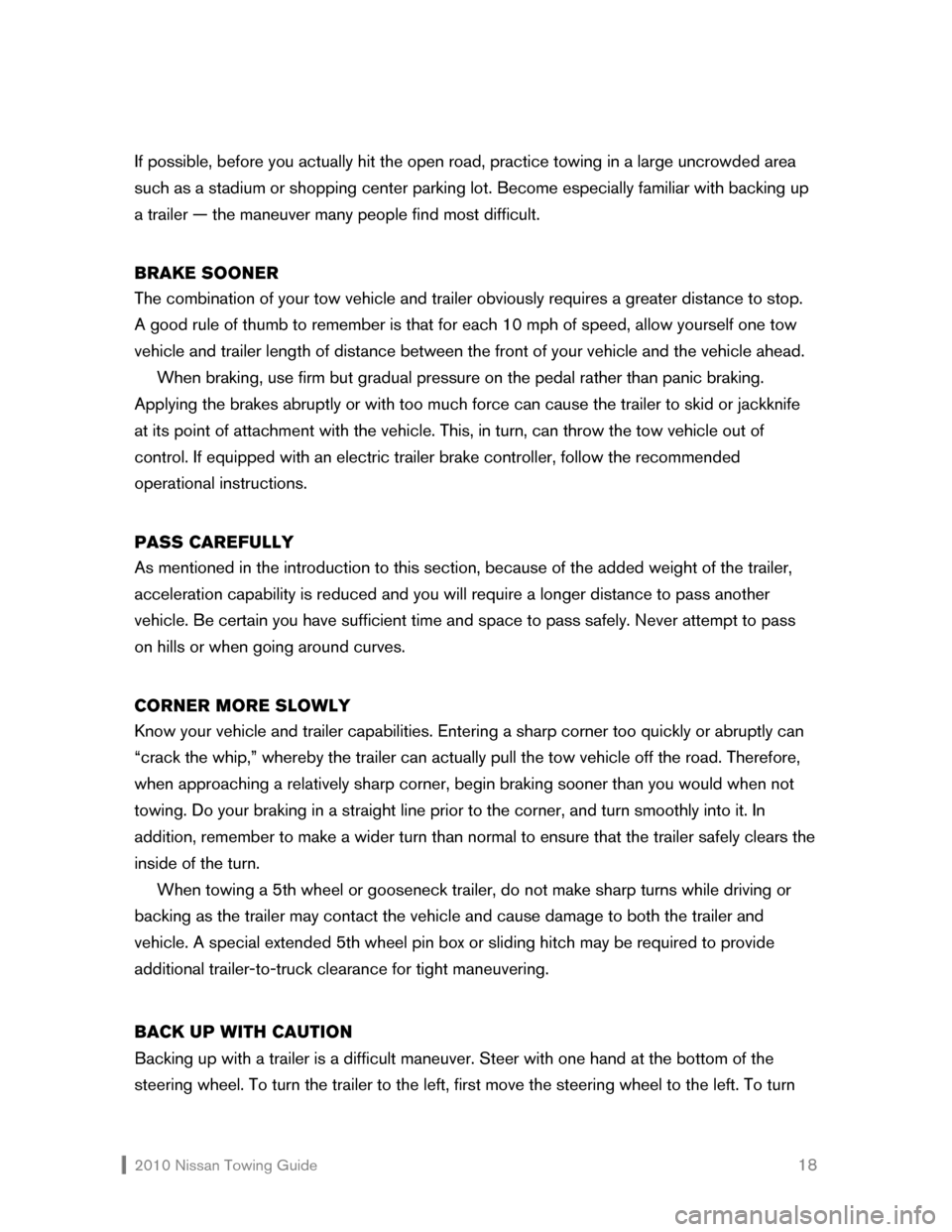
2010 Nissan Towing Guide 18 If possible, before you actually hit the open road, practice towing in a large uncrowded area
such as a stadium or shopping center parking lot. Become especially familiar with backing up
a trailer — the maneuver many people find most difficult.
BRAKE SOONER
The combination of your tow vehicle and trailer obviously requires a greater distance to stop.
A good rule of thumb to remember is that for each 10 mph of speed, allow yourself one tow
vehicle and trailer length of distance between the front of your vehicle and the vehicle ahead.
When braking, use firm but gradual pressure on the pedal rather than panic braking.
Applying the brakes abruptly or with too much force can cause the trailer to skid or jackknife
at its point of attachment with the vehicle. This, in turn, can throw the tow vehicle out of
control. If equipped with an electric trailer brake controller, follow the recommended
operational instructions.
PASS CAREFULLY
As mentioned in the introduction to this section, because of the added weight of the trailer,
acceleration capability is reduced and you will require a longer distance to pass another
vehicle. Be certain you have sufficient time and space to pass safely. Never attempt to pass
on hills or when going around curves.
CORNER MORE SLOWLY
Know your vehicle and trailer capabilities. Entering a sharp corner too quickly or abruptly can
“crack the whip,” whereby the trailer can actually pull the tow vehicle off the road. Therefore,
when approaching a relatively sharp corner, begin braking sooner than you would when not
towing. Do your braking in a straight line prior to the corner, and turn smoothly into it. In
addition, remember to make a wider turn than normal to ensure that the trailer safely clears the
inside of the turn.
When towing a 5th wheel or gooseneck trailer, do not make sharp turns while driving or
backing as the trailer may contact the vehicle and cause damage to both the trailer and
vehicle. A special extended 5th wheel pin box or sliding hitch may be required to provide
additional trailer-to-truck clearance for tight maneuvering.
BACK UP WITH CAUTION
Backing up with a trailer is a difficult maneuver. Steer with one hand at the bottom of the
steering wheel. To turn the trailer to the left, first move the steering wheel to the left. To turn
Page 21 of 30
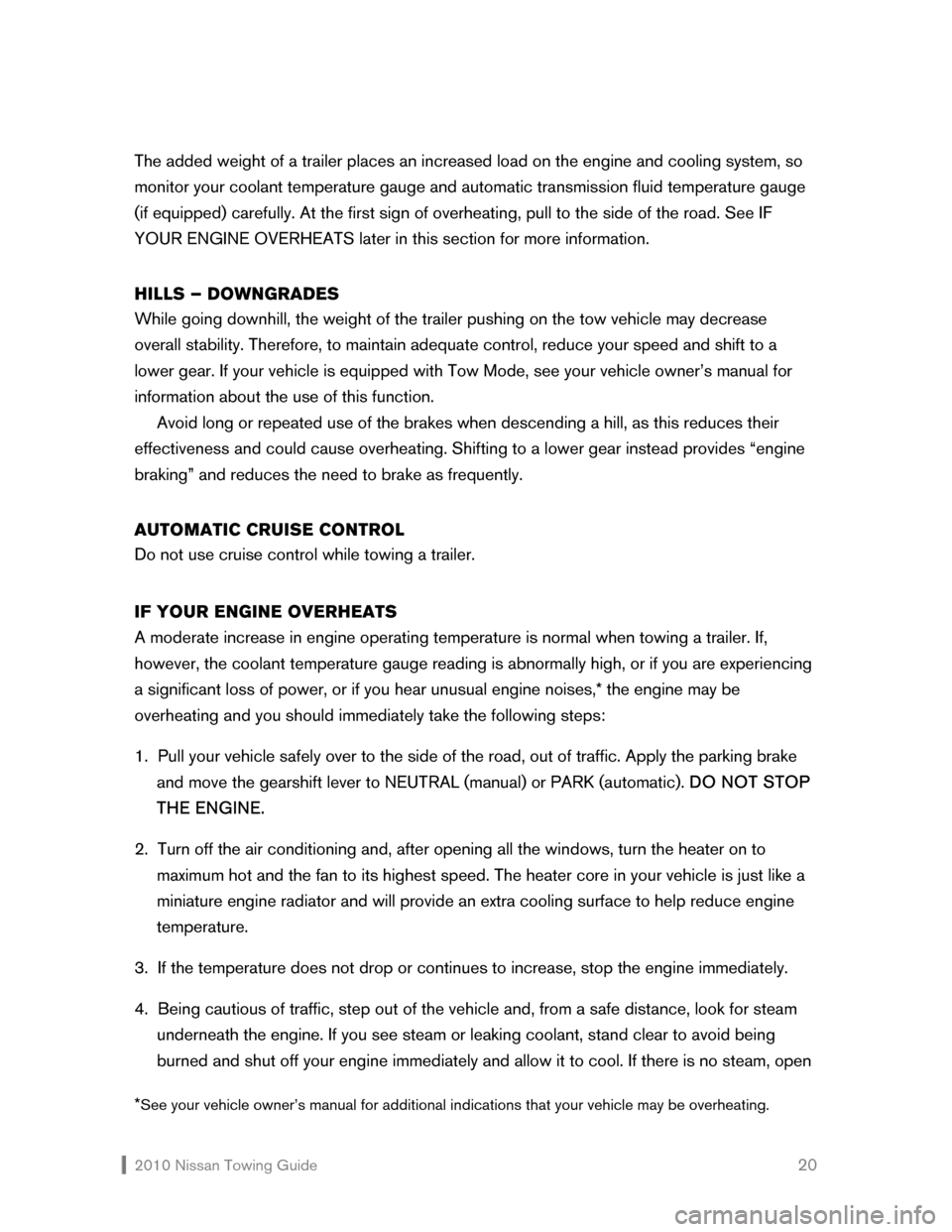
2010 Nissan Towing Guide 20 The added weight of a trailer places an increased load on the engine and cooling system, so
monitor your coolant temperature gauge and automatic transmission fluid temperature gauge
(if equipped) carefully. At the first sign of overheating, pull to the side of the road. See IF
YOUR ENGINE OVERHEATS later in this section for more information.
HILLS – DOWNGRADES
While going downhill, the weight of the trailer pushing on the tow vehicle may decrease
overall stability. Therefore, to maintain adequate control, reduce your speed and shift to a
lower gear. If your vehicle is equipped with Tow Mode, see your vehicle owner’s manual for
information about the use of this function.
Avoid long or repeated use of the brakes when descending a hill, as this reduces their
effectiveness and could cause overheating. Shifting to a lower gear instead provides “engine
braking” and reduces the need to brake as frequently.
AUTOMATIC CRUISE CONTROL
Do not use cruise control while towing a trailer.
IF YOUR ENGINE OVERHEATS
A moderate increase in engine operating temperature is normal when towing a trailer. If,
however, the coolant temperature gauge reading is abnormally high, or if you are experiencing
a significant loss of power, or if you hear unusual engine noises,* the engine may be
overheating and you should immediately take the following steps:
1. Pull your vehicle safely over to the side of the road, out of traffic. Apply the parking brake
and move the gearshift lever to NEUTRAL (manual) or PARK (automatic). DO NOT STOP
THE ENGINE.
2. Turn off the air conditioning and, after opening all the windows, turn the heater on to
maximum hot and the fan to its highest speed. The heater core in your vehicle is just like a
miniature engine radiator and will provide an extra cooling surface to help reduce engine
temperature.
3. If the temperature does not drop or continues to increase, stop the engine immediately.
4. Being cautious of traffic, step out of the vehicle and, from a safe distance, look for steam
underneath the engine. If you see steam or leaking coolant, stand clear to avoid being
burned and shut off your engine immediately and allow it to cool. If there is no steam, open
*See your vehicle owner’s manual for additional indications that your vehicle may be overheating.
Page 23 of 30
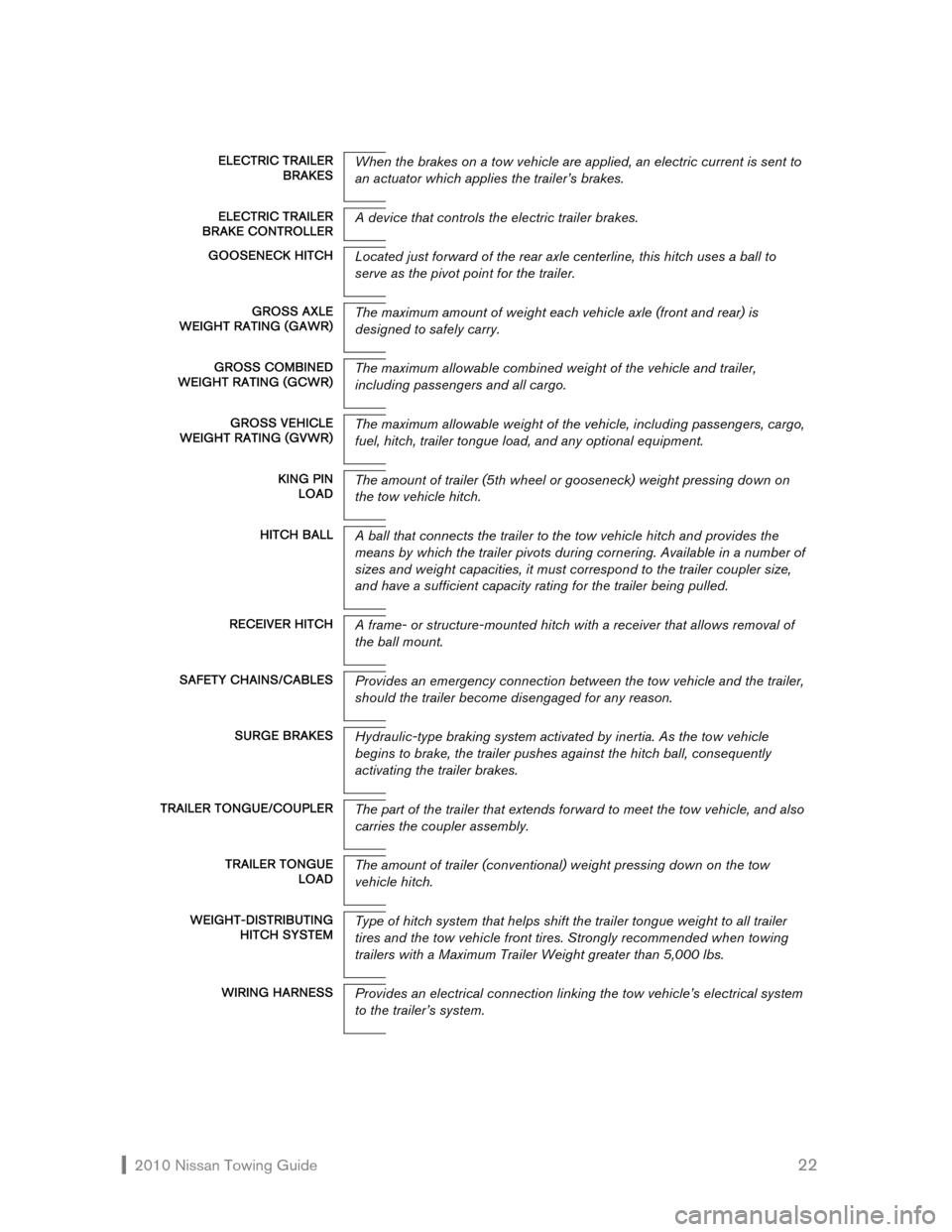
2010 Nissan Towing Guide 22
ELECTRIC TRAILER
BRAKES When the brakes on a tow vehicle are applied, an electric current is sent to
an actuator which applies the trailer’s brakes.
ELECTRIC TRAILER
BRAKE CONTROLLER A device that controls the electric trailer brakes.
GOOSENECK HITCH Located just forward of the rear axle centerline, this hitch uses a ball to
serve as the pivot point for the trailer.
GROSS AXLE
WEIGHT RATING (GAWR)
The maximum amount of weight each vehicle axle (front and rear) is
designed to safely carry.
GROSS COMBINED
WEIGHT RATING (GCWR) The maximum allowable combined weight of the vehicle and trailer,
including passengers and all cargo.
GROSS VEHICLE
WEIGHT RATING (GVWR) The maximum allowable weight of the vehicle, including passengers, cargo,
fuel, hitch, trailer tongue load, and any optional equipment.
KING PIN
LOAD The amount of trailer (5th wheel or gooseneck) weight pressing down on
the tow vehicle hitch.
HITCH BALL
A ball that connects the trailer to the tow vehicle hitch and provides the
means by which the trailer pivots during cornering. Available in a number of
sizes and weight capacities, it must correspond to the trailer coupler size,
and have a sufficient capacity rating for the trailer being pulled.
RECEIVER HITCH A frame- or structure-mounted hitch with a receiver that allows removal of
the ball mount.
SAFETY CHAINS/CABLES Provides an emergency connection between the tow vehicle and the trailer,
should the trailer become disengaged for any reason.
SURGE BRAKES
Hydraulic-type braking system activated by inertia. As the tow vehicle
begins to brake, the trailer pushes against the hitch ball, consequently
activating the trailer brakes.
TRAILER TONGUE/COUPLER The part of the trailer that extends forward to meet the tow vehicle, and also
carries the coupler assembly.
TRAILER TONGUE
LOAD The amount of trailer (conventional) weight pressing down on the tow
vehicle hitch.
WEIGHT-DISTRIBUTING
HITCH SYSTEM Type of hitch system that helps shift the trailer tongue weight to all trailer
tires and the tow vehicle front tires. Strongly recommended when towing
trailers with a Maximum Trailer Weight greater than 5,000 lbs.
WIRING HARNESS
Provides an electrical connection linking the tow vehicle’s electrical system
to the trailer’s system.
Page 24 of 30
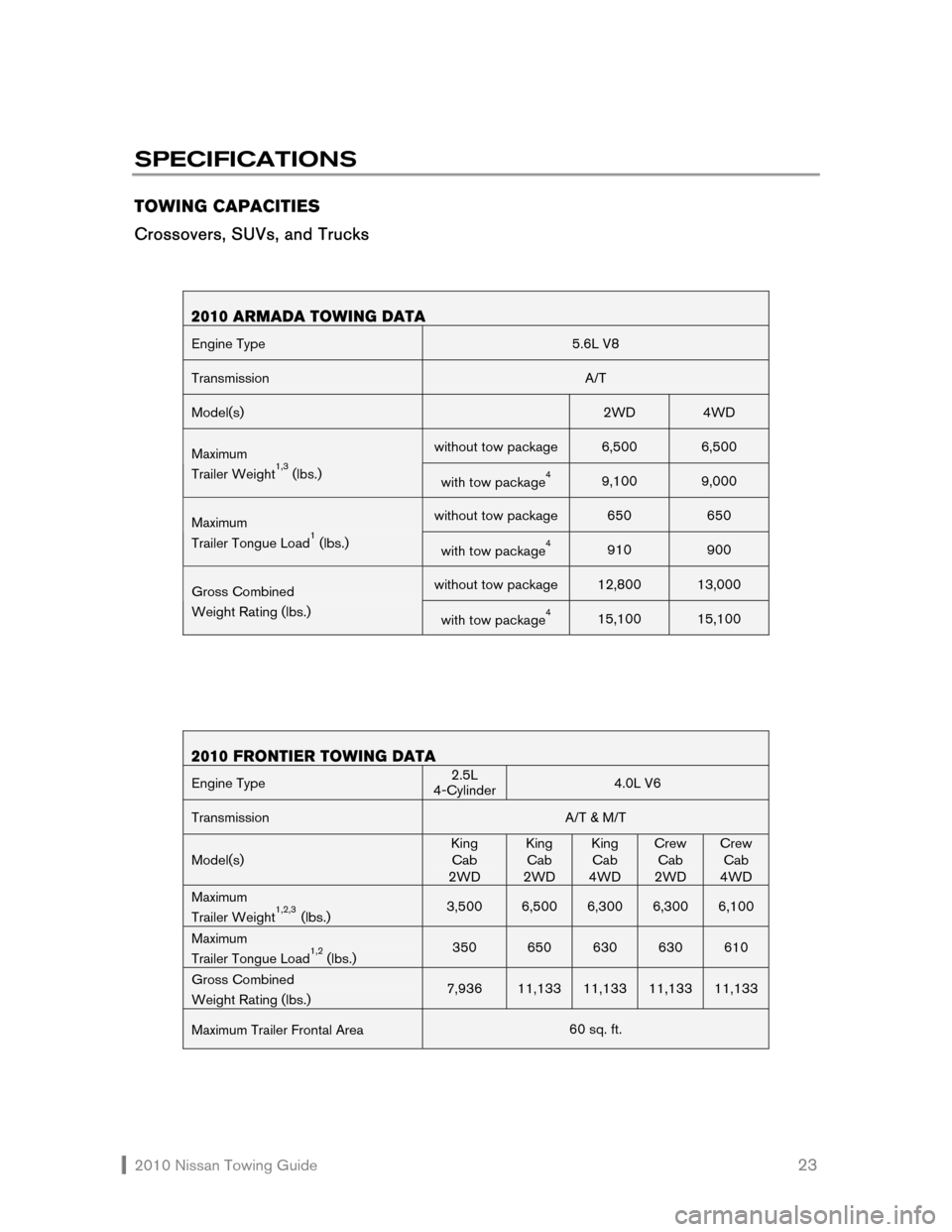
2010 Nissan Towing Guide 23
SPECIFICATIONS
TOWING CAPACITIES
Crossovers, SUVs, and Trucks
2010 ARMADA TOWING DATA
Engine Type 5.6L V8
Transmission A/T
Model(s) 2WD 4WD
without tow package 6,500 6,500 Maximum
Trailer Weight1,3 (lbs.) with tow package4 9,100 9,000
without tow package 650 650 Maximum
Trailer Tongue Load1 (lbs.) with tow package4 910 900
without tow package 12,800 13,000 Gross Combined
Weight Rating (lbs.) with tow package4 15,100 15,100
2010 FRONTIER TOWING DATA
Engine Type 2.5L
4-Cylinder 4.0L V6
Transmission A/T & M/T
Model(s)
King
Cab
2WD
King
Cab
2WD
King
Cab
4WD
Crew
Cab
2WD
Crew
Cab
4WD
Maximum
Trailer Weight1,2,3 (lbs.) 3,500 6,500 6,300 6,300 6,100
Maximum
Trailer Tongue Load1,2 (lbs.) 350 650 630 630 610
Gross Combined
Weight Rating (lbs.) 7,936 11,133 11,133 11,133 11,133
Maximum Trailer Frontal Area 60 sq. ft.
Page 25 of 30
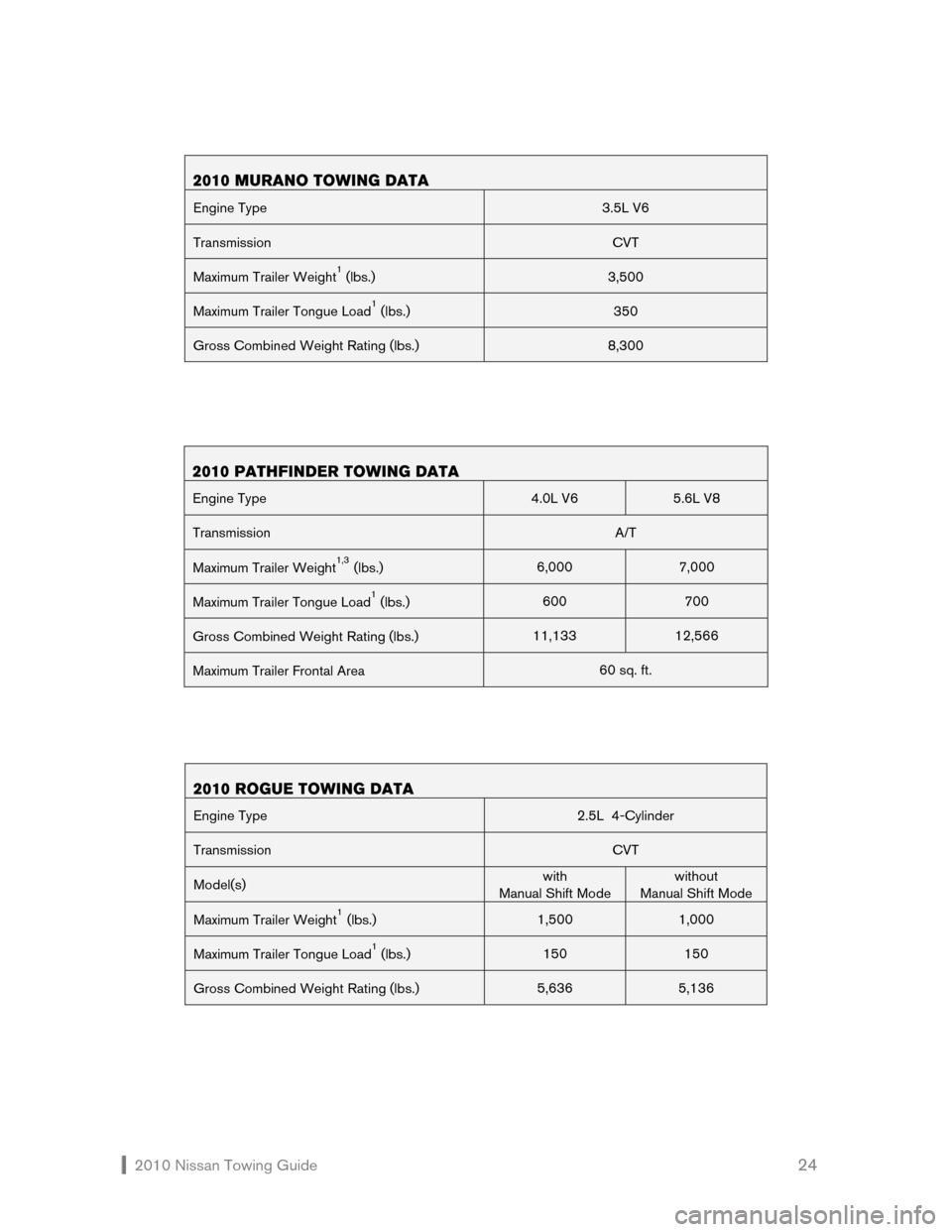
2010 Nissan Towing Guide 24
2010 MURANO TOWING DATA
Engine Type 3.5L V6
Transmission CVT
Maximum Trailer Weight1 (lbs.) 3,500
Maximum Trailer Tongue Load1 (lbs.) 350
Gross Combined Weight Rating (lbs.) 8,300
2010 PATHFINDER TOWING DATA
Engine Type 4.0L V6 5.6L V8
Transmission A/T
Maximum Trailer Weight1,3 (lbs.) 6,000 7,000
Maximum Trailer Tongue Load1 (lbs.) 600 700
Gross Combined Weight Rating (lbs.) 11,133 12,566
Maximum Trailer Frontal Area 60 sq. ft.
2010 ROGUE TOWING DATA
Engine Type 2.5L 4-Cylinder
Transmission CVT
Model(s) with
Manual Shift Mode
without
Manual Shift Mode
Maximum Trailer Weight1 (lbs.) 1,500 1,000
Maximum Trailer Tongue Load1 (lbs.) 150 150
Gross Combined Weight Rating (lbs.) 5,636 5,136
Page 26 of 30

2010 Nissan Towing Guide 25
Passenger Vehicles – The towing capacity for Altima (Coupe, Hybrid, and Sedan), Maxima,
and Sentra vehicles is 1,000 lbs.; the maximum trailer tongue load is 100 lbs. DO NOT
tow a
trailer with 370Z (Coupe and Roadster), cube, GT-R, or Versa.
NOTE – For passenger vehicles, the trailer tongue load must be subtracted from the GVWR
as shown on the F.M.V.S.S. certification label located in the driver’s-side door area.
2010 XTERRA TOWING DATA
Engine Type 4.0L V6
Transmission A/T & M/T
Model(s) 2WD & 4WD
Maximum Trailer Weight1 (lbs.) 5,000
Maximum Trailer Tongue Load1 (lbs.) 500
Gross Combined Weight Rating (lbs.) 9,656
Maximum Trailer Frontal Area 60 sq. ft.
1 Maximum Trailer Weight values are calculated assuming a base vehicle with driver and
any options required to achieve the rating. Additional passengers, cargo and/or optional
equipment will add weight to the vehicle and reduce your vehicle’s maximum towing
capacity and trailer tongue load.
2 The Maximum Trailer Weight when using the Genuine Nissan step bumper in this
application as a ball mount is 3,500 lbs.; the Maximum Trailer Tongue Load is 350 lbs.
3 Use of a weight-distributing hitch system is recommended when towing over 5,000 lbs.
4 The vehicle tow package does not include a ball mount. Ball mount options are available
through your Nissan dealer:
�Š Class III hitch ball mount for trailers with a Maximum Trailer Weight of 5,000 lbs.
or less.
NOTE – A hitch ball is not included with the Class III ball mount.
�Š Class IV weight-distributing hitch ball mount for trailers with a Maximum Trailer
Weight greater than 5,000 lbs. This ball mount can also be used with trailers
under 5,000 lbs. Maximum Trailer Weight.
NOTE – The Class IV ball mount includes a 2
5/16” hitch ball rated for 10,000 lbs. NOTES:
�Š Most states require a separate braking system on trailers with a loaded weight
above a specific amount. Check local ordinances.
�Š A/T – Automatic Transmission, CVT – Continuously Variable Transmission
Page 27 of 30
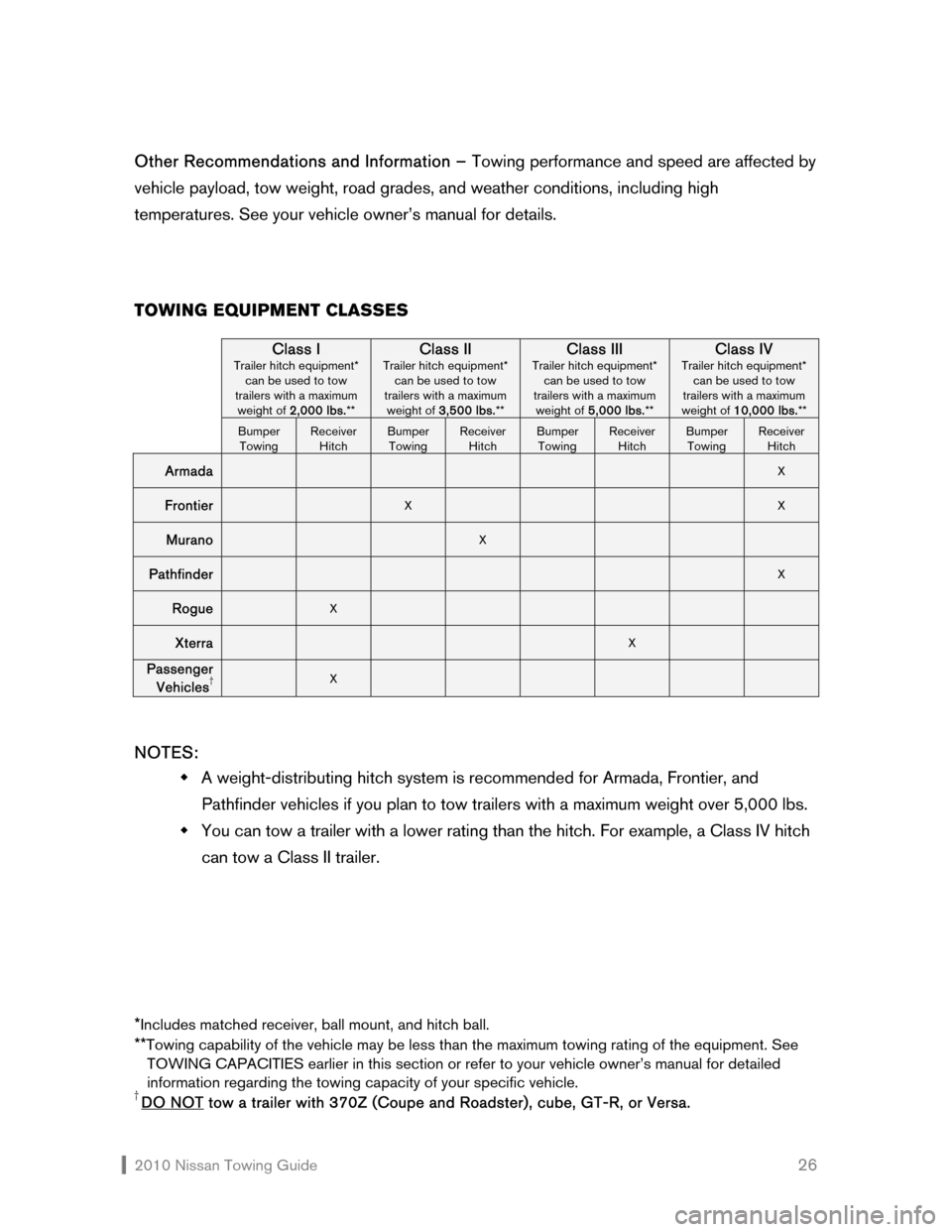
2010 Nissan Towing Guide 26 Other Recommendations and Information – Towing performance and speed are affected by
vehicle payload, tow weight, road grades, and weather conditions, including high
temperatures. See your vehicle owner’s manual for details.
TOWING EQUIPMENT CLASSES
Class I
Trailer hitch equipment* can be used to tow trailers with a maximum weight of 2,000 lbs.**
Class II
Trailer hitch equipment* can be used to tow trailers with a maximum weight of 3,500 lbs.**
Class III
Trailer hitch equipment* can be used to tow trailers with a maximum weight of 5,000 lbs.**
Class IV
Trailer hitch equipment* can be used to tow trailers with a maximum weight of 10,000 lbs.**
Bumper Towing Receiver Hitch Bumper Towing Receiver Hitch Bumper Towing Receiver Hitch Bumper Towing Receiver Hitch
Armada X
Frontier X X
Murano X
Pathfinder X
Rogue X
Xterra X
Passenger
Vehicles† X
NOTES:
�Š A weight-distributing hitch system is recommended for Armada, Frontier, and
Pathfinder vehicles if you plan to tow trailers with a maximum weight over 5,000 lbs.
�Š You can tow a trailer with a lower rating than the hitch. For example, a Class IV hitch
can tow a Class II trailer.
*Includes matched receiver, ball mount, and hitch ball.
**Towing capability of the vehicle may be less than the maximum towing rating of the equipment. See
TOWING CAPACITIES earlier in this section or refer to your vehicle owner’s manual for detailed
information regarding the towing capacity of your specific vehicle.
† DO NOT tow a trailer with 370Z (Coupe and Roadster), cube, GT-R, or Versa.